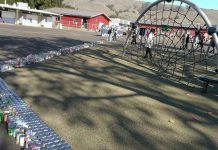Judging only by the clothes they wear, hairstyles, or behavior,
they seem like your average American teenager
– at least until they start talking.
Judging only by the clothes they wear, hairstyles, or behavior, they seem like your average American teenager – at least until they start talking.
And even though many American parents could argue they often don’t understand what their own teenagers say, a group of youths visiting Morgan Hill this week truly spoke a foreign language.
Twenty-one Japanese students from Osaka, Japan took in the sights, sounds and culture of California life this week during a school-sponsored trip designed to develop English skills while experiencing American culture first hand.
“In order to be accepted at the university, they must complete a visit with a host family and learn conversational English,” said Marie Runsvick, one of two American teacher guides with the group and also a host for one of the students.
The students, from Kindai High School in Osaka in the southeast area of Japan’s Tokyo metropolis, gathered at Machado School on Wednesday to improve their conversational English and learn something about Morgan Hill history.
By the time they leave on Sunday, the students will have spent eight days with their host families, learning in English in a traditional classroom setting and soaking in the American culture while learning slang expressions they don’t hear at home such as “dog eat dog” or “come off it.”
Teacher guide Marie Runsvick, who is also hosting one of the students, said the first thing she noticed about the mostly male students, is how polite and well-mannered they are. The students are between the ages of 16 and 18 years old.
“They are so very helpful,” she said. “If they see an opportunity to help, such as when I’m carrying my heavy bag each morning, they always offer to take it for me. They always remember to say please and thank you.”
And though the students have manners, they lack the street smarts of modern American youth, Runsvick said.
“I would say they are like 12-year-olds, in terms of their street smarts,” she said. “They have a simplicity about them, a naivete, that’s breathtaking and very refreshing. They are very respectful towards adults.”
Teacher guide Martha Barajas said the experience of guiding the Japanese students through various lessons is similar to teaching preschool, which she has done in the past.
“There’s a certain basic communication that takes place when language skills are developing, as they are for these students,” she said. “They have studied English at home in Japan, but mostly through reading and writing, so it is our job to help them learn to converse. There’s a certain insight that teachers have, not just the language.”
As teacher guides, Barajas and Runsvick spend nearly as much time with the students as do their host families. But a good part of their time with the students is structured by PeopleLink, the Petaluma-based non-profit company that arranges student visits.
During the students’ instructional periods, Barajas said, teacher guides have specific lessons they can follow.
“But many times I find myself stopping or spending more time on something in the lesson that I believe they need to work on more,” she said. “For example, there were some who did not understand how we use our money, and I saw we needed to spend time on that. Other issues, as they arise, it is important to address so that they can feel more comfortable and learn about our culture.”
The students’ quick visit to Morgan Hill wasn’t all work and no play . The teen-agers truly got a taste of Americana by visiting the mundane places most locals take for granted such as the Post Office, bank and shopping areas. The students also spent a day exploring Pacific Crest Corp. in Santa Clara. Pacific Crest General Manager John Cameron lead the tour.
“I gave them a presentation, talking about the history of the company,” he said, explaining that the company makes wireless modems to be used with GPS systems. “We went out in the back parking lot and demonstrated the equipment in use. They seemed very interested … I also saw a lot of interest, a lot of smiles and nods, when we toured the engineering department, and I pointed out what they’d already observed, that the room was filled with representatives from every continent, multi-national men and women with PhDs, masters and bachelors degrees.”
In an effort to give the students a glimpse of what earning those degrees stateside could be like, they visited Stanford. And of course, no visit to the Bay Area would be complete without a quick trip San Francisco.
Naoki, 17-year-old student on the trip, said he thought the San Francisco visit was one of the best elements of their journey.
“I like the Golden (Gate) Bridge, and Fisherman’s Wharf was fun,” he said in a heavy Japanese accent.
He also described his host family as “very kind,” and said he has a brother and sister in Japan that he thinks would enjoy making a similar trip.
Angela Moore, a “USA mom” hosting one of the students, said she has hosted students for 10 years and still keeps in touch with them.
“We definitely stay in touch,” she said. “They are all so respectful and helpful around the house. It’s such a great program, because not only do they learn so much, but we also learn so much from them. The exchange of cultures is wonderful. And the connections you form … Some of the kids I have had in the past call me their ‘Mom in the USA.’”
One of the things that surprised the students, said Barajas, was the size of things in America.
“They said, ‘You’re all big here, the food is big, the drinks are big, everything is bigger here,’” she said. “They told me the sodas they have in Japan are tiny, so ours seem so much bigger. Of course, they are eating and drinking it all; the attitude seems to be, ‘why not take advantage of it while we’re here?’”
Although the students may differ culturally from American teachers, Barajas said, she still believes there are similarities between all young people regardless of their cultural heritage.
“When you are young, when you’re at this stage in your life, there are concerns and issues that come up no matter where you live,” she said. “Yes, I see the cultural differences, but I also see their similarities.”
Marilyn Dubil covers education and law enforcement for The Times. She can be reached by e-mail at md****@*************es.com or phoning (408)779-4106 Ext. 202.








